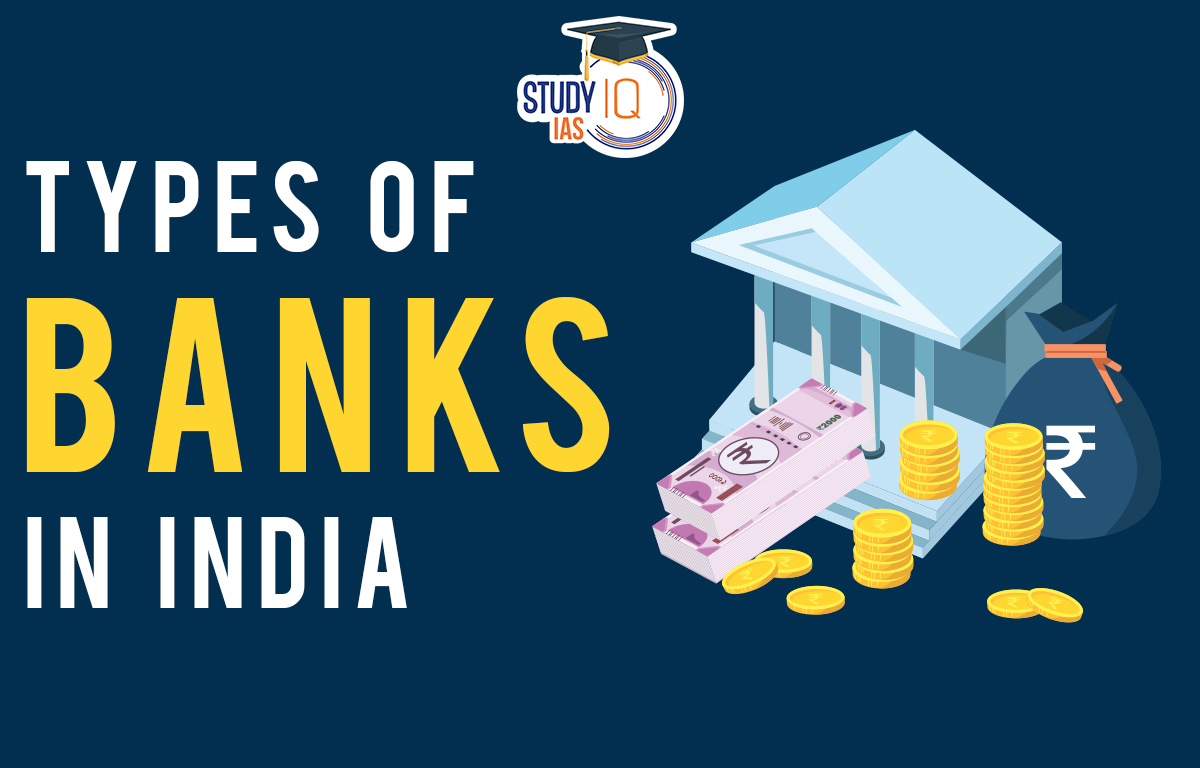Table of Contents
Types of Banks in India
The banking system in India is a large and complex network of banks, financial institutions, and regulatory bodies. The Reserve Bank of India (RBI) is the central bank responsible for regulating and supervising the banking system. It comprises a mix of the public sector, private sector, foreign banks, and specialized banks, which provide a range of banking services to individuals, businesses, and organizations.
The banking system plays a crucial role in supporting the country’s economic growth and development by providing credit, investment, and other financial services to various sectors of the economy.
Read More: Indian Financial System
List of Types of Banks in India
Here is the list of Types of Banks in India banking system.
| S. No | Category | Year of Establishment | Importance in Indian Economy |
| 1. | Public Sector Banks (PSBs) | 1969 onwards | Vital role in providing credit and financial services to various sectors |
| 2. | Private Sector Banks (PVBs) | 1990 onwards | Contributing significantly to the country’s economic growth and development |
| 3. | Foreign Banks | Varies | An important role in providing specialized financial services and contributing to the country’s economic growth |
| 4. | Regional Rural Banks (RRBs) | 1975 onwards | Crucial role in promoting financial inclusion and providing banking services to rural areas |
| 5. | Co-operative Banks | Varies | Significant role in promoting financial inclusion and providing credit and financial services to low-income and rural areas |
| 6. | Payment Banks | 2015 onwards | Potential to revolutionize the banking sector in India by providing basic banking services to underserved and unbanked areas |
| 7. | Small Finance Banks | 2015 onwards | Crucial role in promoting financial inclusion and providing credit and financial services to low-income households and small businesses |
Read about: List of RBI Governors of India
Types of Commerical Banks in India
Commercial banks are the backbone of the Indian banking system. They are financial institutions that provide a range of banking services to individuals, businesses, and other organizations. Commercial banks in India are regulated by the Reserve Bank of India (RBI), which is the central bank of the country.
Commercial banks in India accept deposits from customers, provide loans and credit facilities, and offer a range of other financial services such as foreign exchange transactions, investment advice, and wealth management. They also act as intermediaries between savers and borrowers and help to channel funds from those who have surplus funds to those who need them.
Commercial banks in India can be classified into two categories:
- Scheduled Commercial Banks and
- Non-Scheduled Commercial Banks.
Scheduled Commercial Banks
These are banks that are listed in the Second Schedule of the Reserve Bank of India Act, 1934. These banks have paid-up capital and reserves of at least Rs. 5 crores and are required to maintain a cash reserve ratio (CRR) and a statutory liquidity ratio (SLR) with the RBI. Scheduled commercial banks are further classified into three categories:
- Public Sector Banks (PSBs): These are banks that are owned by the government of India and form the majority of scheduled commercial banks in India.
- Private Sector Banks (PVBs): These are banks that are owned and operated by private companies or individuals.
- Foreign Banks: These are banks that are headquartered in other countries but have operations in India.
Non-Scheduled Commercial Banks
These are banks that are not listed in the Second Schedule of the RBI Act, 1934. These banks are not required to maintain CRR and SLR with the RBI. Non-scheduled commercial banks are typically smaller and cater to a specific customer base. They are not allowed to participate in the call money market or inter-bank money market.
Read about: Finance Ministers of India List
Types of Banks in India UPSC
The topic of types of banks in India is an important one for UPSC aspirants, as it is a part of the UPSC Syllabus for the Economy section. Aspirants who are preparing for the UPSC exam need to have a thorough understanding of the banking system in India and the different types of banks that operate in the country.
The topic is often covered in StudyIQ UPSC Online Coaching classes and UPSC Mock Test to help aspirants prepare for the exam. It is also important to be familiar with the keywords related to this topic, such as public sector banks, private sector banks, foreign banks, regional rural banks, cooperative banks, payment banks, and small finance banks, among others.
Read about: India’s GDP Growth Rate


 Goods and Services Tax (GST), Objectives...
Goods and Services Tax (GST), Objectives...
 World Oceans Day 2025, History, Theme, S...
World Oceans Day 2025, History, Theme, S...
 World Environment Day 2025, Theme, Histo...
World Environment Day 2025, Theme, Histo...





















